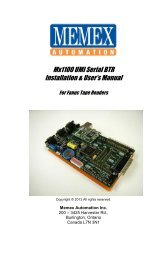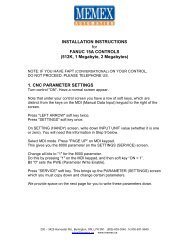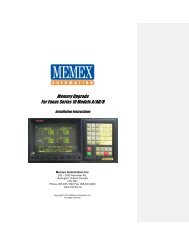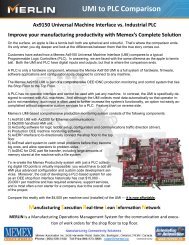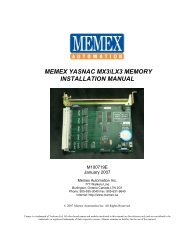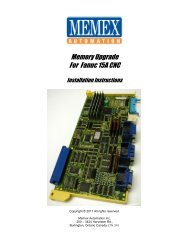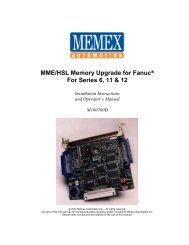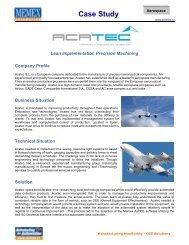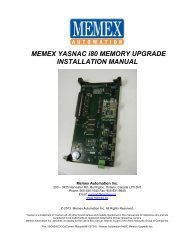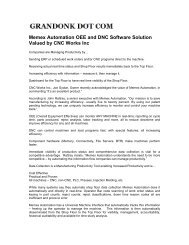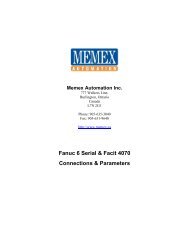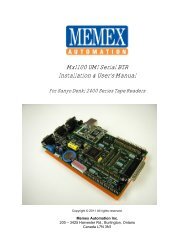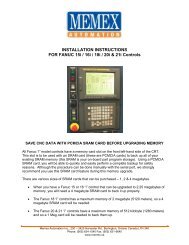Mx1100 Serial BTR for GE Manual - Memex Automation
Mx1100 Serial BTR for GE Manual - Memex Automation
Mx1100 Serial BTR for GE Manual - Memex Automation
Create successful ePaper yourself
Turn your PDF publications into a flip-book with our unique Google optimized e-Paper software.
Behind The Tape Reader<br />
A <strong>BTR</strong> or Behind the Tape Reader, as it is commonly called, is an<br />
electronic signal processor designed to emulate the signals of a<br />
paper Tape Reader; thus providing an alternate method of data<br />
entry to an NC or CNC control. That method, namely RS232 serial<br />
communication, is an international standard <strong>for</strong>m of electronic<br />
communication and data input that is certainly faster and much<br />
more reliable than the conventional method of punching tape or<br />
<strong>Manual</strong> Data Input (MDI).<br />
Originally, the only possible way a G-Code operating program<br />
could be entered into a machine tool was through MDI mode,<br />
which allowed the program to be inputted using a keypad at the<br />
control. The MDI process was fine <strong>for</strong> small programs, but it was<br />
time consuming and error prone <strong>for</strong> longer programs. It took time<br />
to setup and to proof the MDI code be<strong>for</strong>e operation could<br />
commence. Machine flexibility was low, since each new program<br />
required time to input. With all the wasted time and lack of<br />
flexibility, it was not very long be<strong>for</strong>e someone invented an<br />
alternate <strong>for</strong>m of control input, the paper Tape Reader.<br />
The paper Tape Reader provided a faster, more reliable <strong>for</strong>m of<br />
data input to the industrial control. However, these Tape Readers<br />
were mechanical in nature, and required regular maintenance and<br />
care to per<strong>for</strong>m properly. Tape Readers allowed data and programs<br />
that were punched out on a paper tape to be read in by the control<br />
at a rate of approximately 300 to 400 characters per second. A few<br />
problems inherent in the Tape Reader were: its limited ability to<br />
accept commands, its mechanical problems, its limited ability to<br />
in<strong>for</strong>m the operator of problems and status, its need to be kept<br />
clean and its need <strong>for</strong> lubrication and other maintenance. It was<br />
commonly suggested that a busy shop keep a spare reader in<br />
inventory in preparation <strong>for</strong> the time when one broke down. In<br />
spite of the costs associated with Tape Readers, the advantages of<br />
speedy input and reusable tapes were welcome.<br />
Un<strong>for</strong>tunately, the process of punching data tapes (whether they be<br />
paper, mylar or metal) was expensive, lengthy and necessitated<br />
storage concerns. Because of the absolute nature of a punched tape,<br />
the process had to be redone <strong>for</strong> every program revision. As well,<br />
proper communication had to be kept up between the programmer<br />
and operator <strong>for</strong> the tape to be accurate and kept up to date. Old<br />
tapes had to be filed or destroyed while the latest version had to be<br />
vi _ <strong>Mx1100</strong> User’s <strong>Manual</strong>




